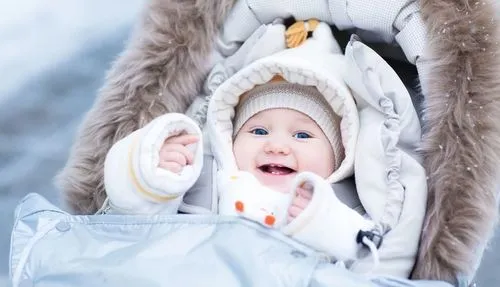The complete guide to baby sleep when travelling
February 22, 2024
Katka

Being a parent often feels like navigating through an entirely new world, and the challenges can multiply when you're travelling internationally with a baby. One major concern for many parents is how to ensure their baby gets proper sleep while on the move. The thought may seem daunting at first, but there's no need to worry. We've put together a comprehensive guide to address this issue and ensure your travel experience with your baby is as comfortable as possible.
This guide will serve as a handy resource, providing you with useful tips and expert advice to help your baby sleep well, no matter your destination.
Understanding baby sleep patterns: The first step to travelling bliss
Firstly, it's essential to understand the nature of baby sleep and how it works. This understanding will help you predict your baby's sleep patterns and prepare accordingly. Sleep is a vital part of your baby's health and growth, and understanding how travel can impact it is a critical step in ensuring their comfort and well-being.
Babies don't just sleep and wake up randomly. Their sleep patterns are influenced by age, growth, and development. The first step to successfully travelling with a baby and ensuring they sleep well is understanding these sleep patterns.
Why do babies have different sleep patterns?
Babies, especially newborns, have shorter sleep cycles and spend a more significant portion of their sleep in the REM stage, known for its light, dream-filled sleep. Consequently, they wake up frequently, primarily to feed due to their small stomach size. As they grow, their sleep patterns gradually become more like those of adults.
Find out more about baby sleep.
How does travel affect a baby's sleep pattern?
Travel, particularly travelling internationally with a baby, can significantly disrupt your baby's sleep pattern due to changes in environment, routine, and time zones. Understanding these potential impacts can help you devise effective strategies to mitigate them.
Pre-travel preparations
The necessary pre-travel preparations can set the stage for a smoother journey. Success in getting your baby to sleep well while travelling largely depends on the steps you take before you even leave your home. Start by gently adjusting your baby's sleep schedule a few days before your travel to align it with the anticipated time zone or travel schedule. If possible, try to maintain your baby's routine during the travel. Keeping meal, play, and sleep times consistent can provide a sense of security and familiarity for your baby.
Don't forget to pack wisely too! Include your baby's familiar sleep aids in your packing list—this can be a favorite blanket, stuffed animal, or even a mobile that they're used to seeing above their crib at home. The goal is to make the new environment mimic their usual sleep environment as closely as possible.

How can pre-travel preparations help my baby sleep better?
1. Align your baby's sleep schedule with your travel itinerary:
If you're travelling across different time zones, try adjusting your baby's sleep schedule gradually.
2. Maintain a consistent sleep routine:
Keeping a regular routine before and during travel can help signal to your baby when it's time to sleep.
3. Pack familiar sleep aids:
Familiar items from your baby's sleep environment can help them feel safe and secure, promoting better sleep.
On the move: Practical tips for helping your baby sleep on the plane, car, or train
Getting a baby to sleep on the move can seem tricky, but with a few practical tips, it becomes a manageable task. Create a cozy and familiar setting for your baby. If you're in a car or on a plane, consider bringing a travel-friendly baby bed that can provide a safe and snug spot for your baby to rest. Also, consider planning your travel times around your baby’s regular nap times. This way, the movement of the vehicle might lull them to sleep, instead of disrupting it.
Control the environment to the best of your ability. This might mean using a light-blocking shade in a sunny car or plane window, or using headphones to buffer loud noises on a train or plane. If permissible, you might consider booking a window seat on a plane which can offer a quieter, more isolated space for your baby.

Sleeping in the plane
Air travel presents unique challenges, but a well-rested baby makes for a smoother flight. If you can, book your flights around your baby's sleep schedule. Use a baby sling or carrier for younger infants—it provides a cozy, secure space and the gentle rocking motion may help soothe them to sleep. For older babies, consider booking a seat with a bassinet, if available. Noise-cancelling headphones for babies can help buffer the unfamiliar sounds of air travel. Also, don't forget to feed or soothe your baby during take-off and landing to help with ear pressure discomfort.
Sleeping in the car
When it comes to getting your baby to sleep in the car, a few strategic steps can make a world of difference. Start by planning your travel times to coincide with your baby's nap times. The gentle motion of the car can actually help lull your baby to sleep. Invest in a high-quality, baby-safe car seat that supports your baby's posture, ensuring they're comfortable throughout the journey. A window shade can help control the amount of sunlight streaming in, while a familiar blanket or soft toy can provide an added layer of comfort. And remember, safety first—always ensure that your baby is properly strapped in.
Sleeping on the train
Train travel can offer a rhythmic motion that babies often find soothing. If you're on a long-distance train, try to book a sleeper cabin for added comfort and privacy. This can provide a dark, quiet space that can mimic the familiarity of their crib at home. Bring along their favorite sleep aids—whether that's a special blanket, pacifier, or a cuddly toy. This can help create a home-like environment in the cabin. It's also worth noting that the hum and rhythm of the train can work as a natural white noise, promoting a calming atmosphere for your baby.
What are some practical tips to help my baby sleep while travelling?
1. Create a comfortable environment: Dress your baby in comfortable clothes and keep the environment at a comfortable temperature.
2. Bring their favourite blanket or comforter: This helps create a familiar environment and serves as a tactile reminder of home.
3. Use a travel-friendly baby bed: A travel cot or portable baby bed can create a familiar and safe space for your baby to sleep.
4. Plan your travel around their nap times: Try to coincide your travel times with your baby's regular sleep times. This is especially helpful when travelling with a baby on a plane.
5. Use white noise: The hum of a plane or the rumble of a train can actually help lull your baby to sleep.
Handling time zone changes: Reducing jet lag for your baby
Long-distance travel often involves crossing multiple time zones, which can throw your baby's sleep schedule into disarray. This sudden shift can cause jet lag, characterized by fatigue, irregular sleep patterns, and general discomfort.
To minimize the impact of jet lag, consider adjusting your baby's sleep schedule gradually in the days leading up to your travel. After you arrive, expose your baby to plenty of daylight (if it's daytime) to help reset their biological clock. Keep them hydrated and encourage regular naps during the day to help them adjust to the new time zone.
How can I reduce the impact of jet lag on my baby?
1. Adjust your baby's sleep schedule gradually: Shift your baby's sleep schedule towards your destination's time zone in the days leading up to your travel.
2. Expose your baby to daylight upon arrival: This can help reset their biological clock.
3. Keep your baby hydrated: Travelling can dehydrate the body, and dehydration can worsen the symptoms of jet lag.
4. Encourage regular naps: Allow your baby to nap according to the new time zone, but don't let them sleep too long. Regular short naps can help them adjust to the new schedule without getting overtired.

Sleeping in a hotel
Staying in a hotel can be an exciting change of pace, but for a baby, it can also be a source of unfamiliarity which may disrupt their sleep. The key to a peaceful slumber in a hotel lies in recreating the comforting environment of home. If possible, book a quiet room where noise levels are low, preferably away from elevators and high-traffic areas. A portable travel crib that your baby is used to can make the new environment feel more familiar.
Don't forget to bring along the essential items that your baby associates with sleep—this might include a favorite blanket, a lovey, or a pacifier. Some parents find it helpful to bring a portable white noise machine or use a white noise app on their phone to mask unfamiliar sounds.
Stick to your regular routines as closely as possible. If you usually read a story before bedtime, continue this ritual in the hotel. Maintaining these regular patterns will signal to your baby that it's time for sleep, just as it would at home. Remember, the goal is to create a sleep environment that mimics what your baby is used to at home, even when you're miles away.
Expert tricks: Proven methods to get your baby to sleep when travelling
Various tools and techniques can work wonders in getting your baby to sleep during travel. White noise machines, for instance, can mimic the constant sounds your baby might be used to hearing in the womb, which can be calming. There are several baby-safe, travel-friendly models available in the market.
Maintaining your bedtime routine as closely as possible can also provide a sense of familiarity and comfort. If you usually read a bedtime story at home, do the same during your travel. This can signal to your baby that it's time to sleep, even in a new environment.
What are some expert-approved methods to help my baby sleep when travelling?
1. Use white noise machines: These can be particularly useful in creating a sleep-friendly environment by drowning out disruptive noises.
2. Stick to your bedtime routine: Try to stick to your usual bedtime routine as closely as possible, even when you're away from home.
**3. Try baby-safe sleep aids: **Some babies might find comfort in baby-safe sleep aids like pacifiers, swaddles, or baby sleep bags. Always ensure safety guidelines are strictly followed when using any sleep aids.
4. Stay calm and patient: Babies often pick up on their parents' anxiety. Staying calm and patient can help your baby feel more relaxed, making it easier for them to fall asleep.

Be ready to make some adjustments
Although we believe it's important for the baby to keep as many routines as possible, making some changes when traveling with your baby is inevitable. Maybe your child doesn't like traveling by car, so it's a good idea to plan longer drives according to your baby's nap time. Sometimes, your baby's nap may be shorter, depending on your baby's needs and your plans. Remember that some sleep is better than no sleep. Skipping the naps can make your baby moody, and tired and disrupt the enjoyable family travel time. When on a walking trip, always take a stroller with you if you can, so your baby can take a nap when needed while you're exploring new places.
Let the technology help you to get your baby to sleep
When traveling, baby monitors can be a great helper to get your baby to sleep. Bibino, a popular baby monitoring app, helps parents all over the world with monitoring their babies. Bibino is perfect for traveling with a baby as you can turn any two devices that you have with you (phones, tablets, laptops) into a reliable baby monitor. With WiFi or mobile data, you can watch over your baby and even soothe your little one remotely when your baby is taking a nap in the next room.

Lullabies and soothing sounds
Although you may not regularly play your baby lullabies at home, they can become very helpful during family travel. Soothing sounds, such as white noise, can eliminate noises in the hotel and help your baby fall asleep.
Bibino baby monitor provides the parents with over 20 different lullabies and soothing sounds to help to get their babies to fall asleep. You can set a timer determining how long the lullaby or sound should be played. You can also record your own lullaby.
Download the Bibino app for free on iOS, Android, and desktop, and make your traveling with the baby more comfortable.

Frequently asked questions
Navigating through the complex world of baby sleep while travelling can raise a lot of questions. Here are answers to some of the most frequently asked ones.
1. How can I comfort my baby to sleep in a new environment?
Creating a familiar environment can be highly effective in comforting your baby in a new place. Bring along their favourite blanket, pillow, or stuffed animal. Also, maintaining a familiar bedtime routine can help signal to your baby that it's time to sleep, even if they're in a new place.
2. What should I avoid to ensure my baby sleeps well during travel?
Avoid exposing your baby to screens before bedtime, as the blue light can hinder the production of melatonin, a sleep-inducing hormone. Also, try not to overstimulate them before sleep time. A quiet, calm pre-sleep routine can be more conducive to sleep. Be mindful of their sugar intake too; too much sugar can cause them to be hyperactive and interfere with their sleep.
3. What if my baby has trouble sleeping on the plane?
Try using a baby sling or carrier that can mimic the rocking motion they might be used to at home. The hum of the plane engine can also serve as white noise, helping them drift off to sleep. If they're having trouble sleeping due to ear discomfort during take-off or landing, encourage swallowing by nursing or offering a pacifier.
4. How can I help my baby adjust to a new time zone?
Help your baby adjust to a new time zone by gradually shifting their sleep schedule in the days leading up to your travel, exposing them to natural light during the day, and maintaining a regular sleep schedule. It's also beneficial to adjust their meal and nap times gradually to align with the new time zone.
5. What's the best travel gear to ensure my baby sleeps comfortably?
Investing in some travel-specific gear can make a world of difference in ensuring your baby's comfort during travel. Consider a comfortable, portable travel crib, a cosy baby blanket, a white noise machine, and window shades for car travel.
Conclusion
Ensuring your baby gets quality sleep when travelling doesn't have to be an insurmountable task. As we've discussed throughout this comprehensive guide, a mix of careful planning, thorough preparation, and the application of practical tips can make a world of difference. From understanding your baby's sleep patterns to making adjustments for timezone changes, every step you take contributes to the overall comfort and well-being of your little one.
When you successfully apply the strategies mentioned in this guide, you don't just guarantee restful sleep for your baby, but also enhance the quality of your journey and overall travel experience. Travelling with a baby doesn't need to be a stress-inducing event. Instead, it can be transformed into an enriching and fulfilling adventure for both you and your child.
Remember, patience is key in this process. It's natural for babies to take time to adjust to new environments and schedules. Your understanding and patience during this adjustment period will go a long way in ensuring smooth travels.
Continue reading...
Show all articlesCopyright & trademark notices
Apple, the Apple logo, and iPhone are trademarks of Apple Inc., registered in the U.S. and other countries and regions. App Store is a service mark of Apple Inc. Mac App Store is a service mark of Apple Inc. Google Play and the Google Play logo are trademarks of Google LLC. Windows® and the Windows logo are either registered trademarks or trademarks of Microsoft Corporation in the United States and/or other countries. Linux® is the registered trademark of Linus Torvalds in the U.S. and other countries.


